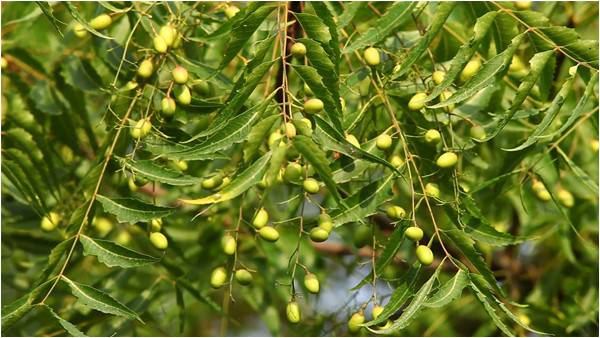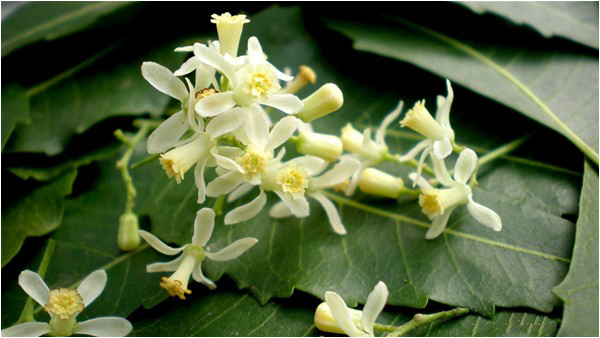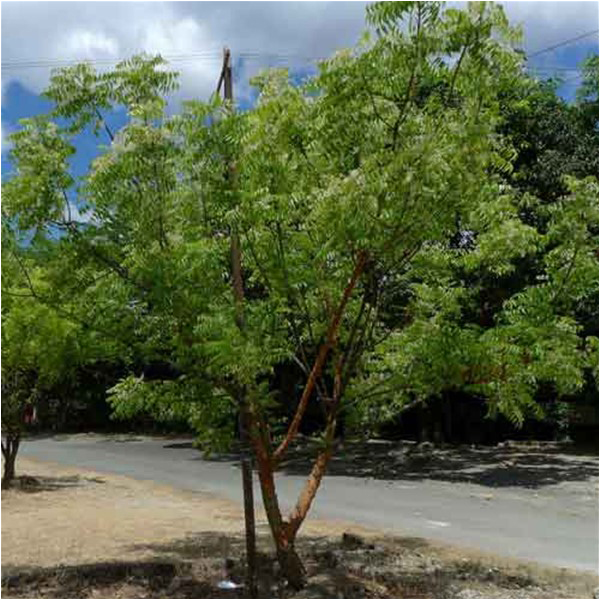
Neem is in full bloom these days and some of the flowers have already turned into olive-like green fruits that turn golden yellow as they ripen. This is when the seeds can be collected to be planted.
This fast growing evergreen tree has a high germination rate and in some parts of South Asia, it is also considered a weed because of its ability to self-seed and multiply with minimum resources. Its drought-tolerant nature allows it to grow in areas that receive little rainfall or have poor soil. The tree can reach 15-20 metres or 49 to 66 feet in height. Occasionally, it can even go up to 40 metres in height. The branches spread wide and create a dense crown that offers a blissful shade in summers.

The ‘life giving tree’ or the ‘divine tree’ are just a few names given to the evergreen Neem. Natives of South Asia have appreciated its medicinal and healing qualities for some 5,000 years now. But contemporary city life has made us so preoccupied that we have forgotten to appreciate this humble tree.
Neem is well known for its healing abilities. This is the reason why the Vedas referred to Neem as “Sarva roga nivarini” which means “one that cures all ailments”. In Sanskrit, Neem is called “Nimba” which simply means “good health”.
Each part of the Neem tree is blessed with healing powers. Ancient Indians and Persians used the flowers, seeds, leaves, roots, bark and twigs of this tree for their antibacterial, antifungal, antiseptic and other properties. Both cultures have enjoyed their own secret recipes but some are very simple and commonly known.
Here are a few ways you can include Neem in your health routine.
Healing Leaves
Neem leaves are dried and burned to repel bugs, cooked with aubergine to make a delicious Tamil meal and juiced to make a super-healthy anti-inflammatory metabolism-boosting drink.
These miraculous leaves not only purify blood, prevent damage, remove toxins, soothe ulcer and heal insect bites – but also protect against bacterial infections! They are also used as a cure for burns and skin problems.
To get rid of dandruff, boil a handful of neem leaves till the water turns green. Let it cool down and use it as water for the final wash after shampooing.
Neem leaf paste can be applied on wounds and insects bites for fast relief.
Chew some neem leaves for better immunity.
Combine Neem leaves with turmeric to make a paste to use for skin problems like itching, eczema, ring worms, etc.

Fragrant Flowers
The delicate white flowers are aromatic at night. Unlike the leaves, these flowers are sweet and are used in meals frequently. For South Indians, these flowers become a part of meals especially during the monsoon – when the trees are at full bloom.
They are also used in aromatherapy because of their calming effect. Tea brewed from these flowers also helps relieve headaches.
Natural Toothbrush
For old-fashioned and eco-friendly people, the twigs of the Neem tree have always been a favourite natural toothbrush!
This toothbrush fights germs and helps treat swollen gums.

Magic of Neem Oil
The seeds are collected and dried for seed oil extraction. The oil is used in organic farming to repel pests and also in cosmetics and other beauty products like soaps, hair oils, hand-washes etc. It is a cure for many kinds of skin disease.
Mix Neem Oil with water and apply on skin to prevent blackheads. It is excellent for nourishing skin and also for hair growth.
Grow your own Neem Tree
Right now would be the perfect time to collect seeds and plant them in pots where they will quickly grow. The drought-resistant tree will need little attention and is ideal for mass plantation across cities like Karachi where heat waves and a lack of green cover are causing serious problems.
Neem will grow in many different types of soils but will perform best in a well drained sandy soil. It can tolerate very high temperatures and also a low of 4 C. It is a perfect tree for the dry coastal areas and southern districts of Pakistan.
The shade of the Neem tree is, quite frankly, unmatchable! I used to have outdoor ‘Learning Garden’ classes under the shade of a Neem tree .The cover was so wide and dense that my entire group of 30 children could easily find refuge under it. And this is precisely what the trees are for.
Why don’t we sit under a tree anymore? I wonder.
Zahra Ali is a sustainability educator, writer and environmentalist. She blogs at cropsinpots.pk. Send in questions about gardening to Zahra@cropsinpots.pk
This fast growing evergreen tree has a high germination rate and in some parts of South Asia, it is also considered a weed because of its ability to self-seed and multiply with minimum resources. Its drought-tolerant nature allows it to grow in areas that receive little rainfall or have poor soil. The tree can reach 15-20 metres or 49 to 66 feet in height. Occasionally, it can even go up to 40 metres in height. The branches spread wide and create a dense crown that offers a blissful shade in summers.

The ‘life giving tree’ or the ‘divine tree’ are just a few names given to the evergreen Neem. Natives of South Asia have appreciated its medicinal and healing qualities for some 5,000 years now. But contemporary city life has made us so preoccupied that we have forgotten to appreciate this humble tree.
Neem is well known for its healing abilities. This is the reason why the Vedas referred to Neem as “Sarva roga nivarini” which means “one that cures all ailments”. In Sanskrit, Neem is called “Nimba” which simply means “good health”.
Each part of the Neem tree is blessed with healing powers. Ancient Indians and Persians used the flowers, seeds, leaves, roots, bark and twigs of this tree for their antibacterial, antifungal, antiseptic and other properties. Both cultures have enjoyed their own secret recipes but some are very simple and commonly known.
Here are a few ways you can include Neem in your health routine.
Each part of the Neem tree is blessed with healing powers. Ancient Indians and Persians used the flowers, seeds, leaves, roots, bark and twigs of this tree their antibacterial, antifungal, antiseptic and other properties
Healing Leaves
Neem leaves are dried and burned to repel bugs, cooked with aubergine to make a delicious Tamil meal and juiced to make a super-healthy anti-inflammatory metabolism-boosting drink.
These miraculous leaves not only purify blood, prevent damage, remove toxins, soothe ulcer and heal insect bites – but also protect against bacterial infections! They are also used as a cure for burns and skin problems.
To get rid of dandruff, boil a handful of neem leaves till the water turns green. Let it cool down and use it as water for the final wash after shampooing.
Neem leaf paste can be applied on wounds and insects bites for fast relief.
Chew some neem leaves for better immunity.
Combine Neem leaves with turmeric to make a paste to use for skin problems like itching, eczema, ring worms, etc.

Fragrant Flowers
The delicate white flowers are aromatic at night. Unlike the leaves, these flowers are sweet and are used in meals frequently. For South Indians, these flowers become a part of meals especially during the monsoon – when the trees are at full bloom.
They are also used in aromatherapy because of their calming effect. Tea brewed from these flowers also helps relieve headaches.
Natural Toothbrush
For old-fashioned and eco-friendly people, the twigs of the Neem tree have always been a favourite natural toothbrush!
This toothbrush fights germs and helps treat swollen gums.

Magic of Neem Oil
The seeds are collected and dried for seed oil extraction. The oil is used in organic farming to repel pests and also in cosmetics and other beauty products like soaps, hair oils, hand-washes etc. It is a cure for many kinds of skin disease.
Mix Neem Oil with water and apply on skin to prevent blackheads. It is excellent for nourishing skin and also for hair growth.
Grow your own Neem Tree
Right now would be the perfect time to collect seeds and plant them in pots where they will quickly grow. The drought-resistant tree will need little attention and is ideal for mass plantation across cities like Karachi where heat waves and a lack of green cover are causing serious problems.
Neem will grow in many different types of soils but will perform best in a well drained sandy soil. It can tolerate very high temperatures and also a low of 4 C. It is a perfect tree for the dry coastal areas and southern districts of Pakistan.
The shade of the Neem tree is, quite frankly, unmatchable! I used to have outdoor ‘Learning Garden’ classes under the shade of a Neem tree .The cover was so wide and dense that my entire group of 30 children could easily find refuge under it. And this is precisely what the trees are for.
Why don’t we sit under a tree anymore? I wonder.
Zahra Ali is a sustainability educator, writer and environmentalist. She blogs at cropsinpots.pk. Send in questions about gardening to Zahra@cropsinpots.pk

